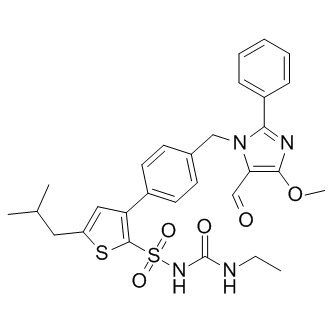AVE 0991CAS号: 304462-19-9分子式: C29H32N4O5S2分子量: 580.72描述纯度储存/保存方法别名可溶性/溶解性靶点In vitro(体外研究)In vivo(体内研究)
| 产品描述 | |
| 描述 |
AVE 0991 is a nonpeptide and orally active angiotensin-(1-7) receptor agonist with an IC50 of 21 nM.
|
| 纯度 |
98%
|
| 储存/保存方法 |
Store at -20℃ for one year(Powder);Store at 2-4℃ for two weeks;Store at -20℃ for six months after dissolution.
|
| 基本信息 | |
| 别名 |
AVE0991
|
| 可溶性/溶解性 |
DMSO : 41.67 mg/mL (71.76 mM; Need ultrasonic)
|
| 生物活性 | |
| 靶点 |
Angiotensin Receptor
|
| In vitro(体外研究) |
AVE 0991 is a nonpeptide compound that evokes effects similar to Ang-(1-7) on the endothelium. AVE 0991 and unlabeled Ang-(1-7) compete for high-affinity binding of -Ang-(1-7) to bovine aortic endothelial cell membranes with IC50s of 21±35 and 220±280 nM, respectively. Peak concentrations of NO and O2- release by AVE 0991 sodium salt and Ang-(1-7) (both 10 μM) are not significantly different (NO: 295±20 and 270±25 nM; O2-: 18±2 and 20±4 nM). However, the released amount of bioactive NO is ≈5 times higher for AVE 0991 in comparison to Ang-(1-7).
|
| In vivo(体内研究) |
AVE 0991 (0.58 nmol/g) produces a significant decrease of water diuresis in WT mice compared with vehicle-treated animals (0.06±0.03 mL versus 0.27±0.05; n=9 for each group; P2O versus 681.1±165.8 mOsm/KgH2O in vehicle-treated mice; PMas abolishes the antidiuretic effect of AVE 0991 during water loading (0.37±0.10 mL versus 0.27±0.03 mL in AVE 0991-treated mice). As observed with C57BL/6 mice, administration of AVE 0991 (0.58 nmol/g) in water-loaded Swiss mice also produces a significant decrease of the urinary volume compared with vehicle-treated animals (0.13±0.05 mL versus 0.51±0.04 mL ; P. One week of treatment with AVE-0991 produces a significant decrease in perfusion pressure (56.55±0.86 vs. 68.73±0.69 mmHg in vehicle-treated rats) and an increase in systolic tension (11.40±0.05 vs. 9.84±0.15 g in vehicle-treated rats), rate of tension rise (+dT/dt; 184.30±0.50 vs. 155.20±1.97 g/s in vehicle-treated rats), rate of tension fall (−dT/dt; 179.60±1.39 vs. 150.80±2.42 g/s in vehicle-treated rats). A slight increase in heart rate (HR) is also observed (220.40±0.71 vs. 214.20±0.74 beats/min in vehicle-treated rats.
|
分子结构图

